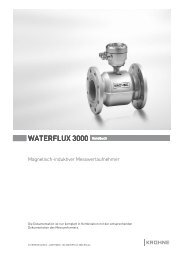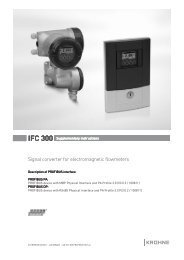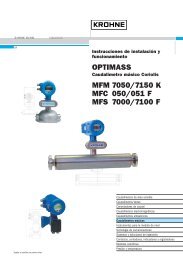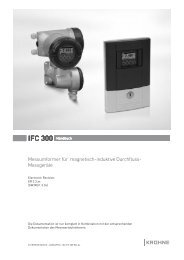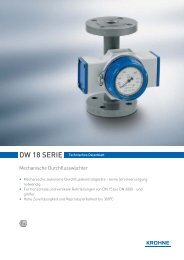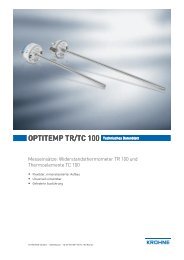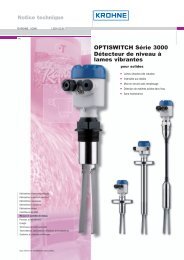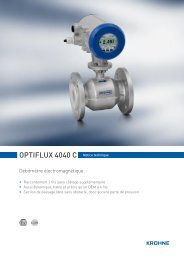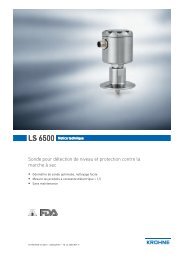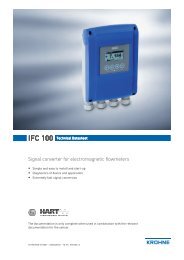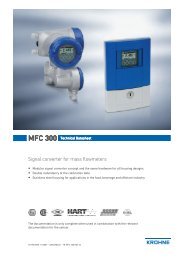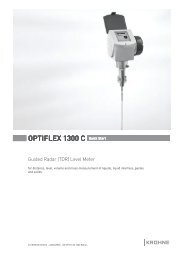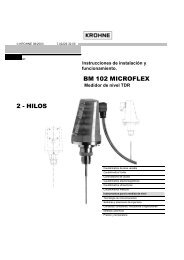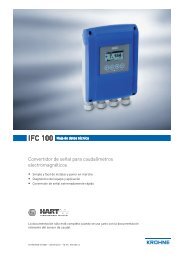Fundamentals of profibus pa networks - Krohne
Fundamentals of profibus pa networks - Krohne
Fundamentals of profibus pa networks - Krohne
Create successful ePaper yourself
Turn your PDF publications into a flip-book with our unique Google optimized e-Paper software.
5.6 The cycle time<br />
Dynamic information is exchanged between field device and the Class 1 master during one<br />
cycle, i.e. 5 bytes useful data per cycle for e.g. a simple measuring device (approx. 15 ms).<br />
This may be e.g, the pressure and the status <strong>of</strong> a pressure gauge. In more complex devices,<br />
such as a mass flow meter which is ca<strong>pa</strong>ble <strong>of</strong> supplying several values, the cycle time per<br />
additional cyclic value increases approx. 1.3 ms.<br />
The cycle time <strong>of</strong> the PA segment is directly dependent on the number <strong>of</strong> connected devices<br />
and the number <strong>of</strong> values being transmitted. Since the majority <strong>of</strong> devices transmit only one<br />
dynamic value, 5 bytes useful data per device can be presumed for an approximate calculation<br />
<strong>of</strong> the cycle time. If it is further assumed that the baud rate on the DP side is selected<br />
such that it does not constitute any appreciable bottleneck for the PA segment data, the<br />
delay on the DP side can be neglected (at 12 Mbauds, this is max. 1 ms). Fig. 5 illustrates<br />
the interrelation ship.<br />
For the acyclic services, a time window per cycle is provided for transmission <strong>of</strong> e.g.<br />
<strong>pa</strong>rameterization data. This is specified during configuration <strong>of</strong> the network. A realistic value<br />
<strong>of</strong> 20 ms has been assumed in the following calculation.<br />
Cycle time = number <strong>of</strong> devices x 15ms + 20ms for acyclic services <strong>of</strong> the Class 2 master<br />
+ 1.3ms for every additional cyclic value.<br />
Example: Given 9 connected devices, the cycle time is approx. 155 ms.<br />
5.7 Remote l/O and redundancy<br />
When speaking <strong>of</strong> redundancy, it must be clearly defined what level <strong>of</strong> redundancy is actually<br />
meant. This may be anything up to full redundancy, where everything is <strong>of</strong> redundant<br />
design, starting with the PLC and ending with the fleld devices. As far as the fleld devices<br />
are concerned, there is no telling whether these will ever feature a redundant bus<br />
connection. The reliability <strong>of</strong> a conventional system with an l/O board <strong>of</strong> a PNK, to which the<br />
e.g. 8 devices are connected, and <strong>of</strong> a PA segment (segment coupler in the control room)<br />
also with approx. 8 devices, is com<strong>pa</strong>rable. If redundant design was not needed earlier it<br />
will not be needed now either.<br />
PROFIBUS PA 13<br />
5



